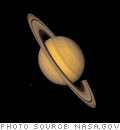Saturn

 |
Saturn, the second-largest planet in the solar system, is the least dense. Its mass is 95 times the mass of Earth and its density is 0.70 gram per cubic centimeter, so that it would float in an ocean if there were one big enough to hold it.
Saturn radiates about 80% more energy than it receives from the Sun. However, the excess thermal energy cannot be primarily attributed to Saturn's primordial heat loss, as is speculated for Jupiter.
Saturn's diameter is 74,978 mi (120,660 km) but 10% less at the poles, a consequence of its rapid rotation. Its axis of rotation is tilted by 27° and the length of its day is 10 hours, 39 minutes, and 24 seconds.
Saturn is composed primarily of liquid metallic hydrogen (about 80%) and the second most common element is believed to be helium.
Saturn's atmospheric appearance is very similar to Jupiter's with dark and light cloud markings and swirls, eddies, and curling ribbons; the belts and zones are more numerous and a thick haze mutes the markings. Temperatures recorded by Voyager II ranged from 82°K (–312°F) to 143°K (–202°F).
Winds blow at extremely high speeds on Saturn. Near the equator, the Voyagers measured winds of about 1,100 mph (500 meters per second). The winds blow primarily in an eastward direction.







